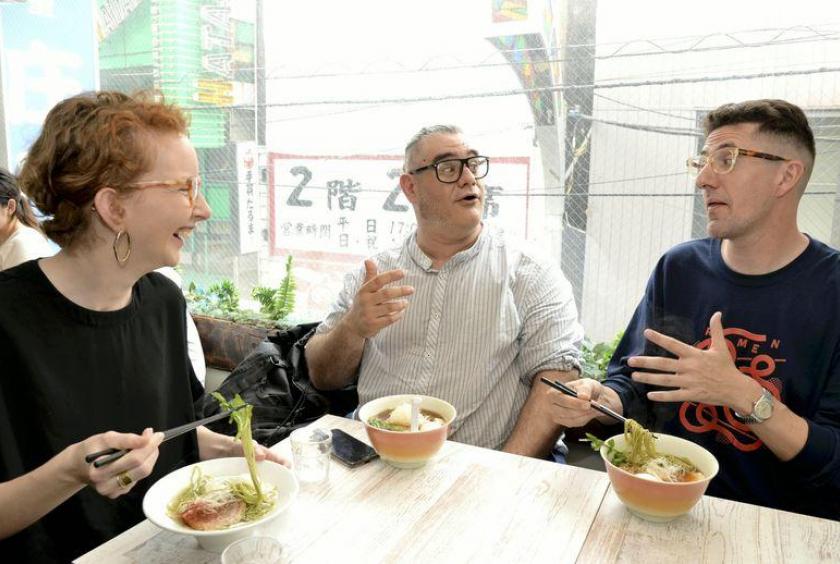
Pizza and shaved ice are not usually what comes to mind when thinking of ramen, but this was not your typical lunch. I was tagging along on a tour with Brian MacDuckston, a ramen obsessive based in Tokyo who runs the Ramen Adventures blog.
The guest of the day was Italian chef Giancarlo Sbolli, who has his own ramen shop, Verderamen, in Brescia, Italy. He had requested “unique ramen,” and to fill the brief MacDuckston was taking us to Oimachi in Shinagawa Ward, Tokyo.
A San Francisco native who has been in Japan for 12 years, MacDuckston’s profile grew after he was featured in a 2010 New York Times article about ramen in Tokyo. He has since made a name for himself through his online reviews and YouTube channel, which has nearly 53,000 followers. He runs private ramen tours for foreigners looking to dive into the Tokyo scene, and he’s also published two books: a 2015 guide to his top 50 shops in Tokyo, and a cookbook with an Osaka ramen school in 2017.
But MacDuckston looked embarrassed when Sbolli said he’s famous overseas. “I just eat a lot of ramen, if you can be famous for that,” he said.
Hot and cold
The first of the two shops on our agenda, ajito ism, has a large fanbase for its award-winning mazesoba soupless noodles.
Unfortunately the original restaurant, about a 10-minute walk from Oimachi Station, was closed for renovations the day of our tour — but it was also the opening day for their new shop in Shinjuku, which we planned to check out later. First, we were on to another Oimachi destination: Bum Bun Blau Cafe.
A one-minute walk from Hatanodai Station on the Tokyu Ikegami and Oimachi lines, Bum Bun Blau is one of several ramen shops that also serve kakigori shaved ice.
We joined a short line, although MacDuckston told us that in summer, lines at such shops can be two or three hours long. “Kakigori nerds eat one or two kakigori and then the ramen, and then they’ll eat more kakigori,” he said, by way of explanation.
After placing our orders, we found ourselves seated next to one such fan, although of more moderate inclinations.
“I come here about once a week,” said young mother Airi Kato. Is it the ramen or the shaved ice that brings her back? “Both,” she said. “That’s the reason why I like this shop.”
As she and MacDuckston chatted about their favorite shops, our noodles arrived — and they were green. “Spirulina,” MacDuckston told us, referring to a type of blue-green algae regarded as a health food.
This is one shop aiming to keep you healthy while you enjoy their food. There is even a “superfood ramen” on the menu. As it was my first visit, I went with a classic shio salt-based ramen. The others ordered the restaurant’s signature shoyu soy sauce bowl.
Our food arrived and MacDuckston made a declaration: no more than 30 seconds for photos before eating. “It’s the ramen rule,” he said, and despite his smile I could tell he wasn’t joking.
It was time to slurp. The shio broth was light but did not skimp on flavor, and MacDuckston informed us that they use ago flying fish in the base. The noodles were topped with two types of meat — chashu braised pork belly and chicken — egg, a pile of shredded radish and a stem of leafy green mitsuba.
Chef Sbolli was appreciative. “The egg is perfect,” he said. Sbolli trained at the Miyajima Ramen School in Osaka, but this was his first trip to Tokyo. Throughout the afternoon, he and MacDuckston traded notes on shops and discussed the merits of not making noodles by hand.
With bellies full of warm ramen, our shaved ice concoctions arrived, cold air curling off the sides. I could see the appeal of this combination of hot and cold, savory and sweet. I dug into my choice of salt caramel, but not without jealously eyeing another customer’s, which was covered in thick strawberry sauce.
It’s all noodles to me
Our next stop was the brand new outlet for ajito ism. We jumped on the train from Hatanodai, landing in Nishi-Shinjuku, which has a very different vibe to the quiet backstreets of Oimachi.
We were there for the famous pizza soba. This is the dish that sees ajito ism rank highly every year in the mazesoba of the year award from Tokyo Ramen of the Year (TRY) magazine. It’s an unusual fusion of Italian and Japanese flavors that could so easily go wrong — but somehow doesn’t.
It being our second bowl, MacDuckston suggested sukuname, or a small serving of noodles. It was the toppings that grabbed my attention anyway: fresh diced tomato, onion and bell pepper, olives, anchovies, slightly bitter leafy greens, and pepperoni.
The noodles were thick and chewy and picked up the fresh tomato sauce and crisp vegetables well.
Sbolli, however, was not convinced. “It should be either pasta or ramen,” he said. I guessed the other menu items, which included carbonara ramen, wouldn’t fly with him either.
Difficult as I was finding it to finish my second lunch, I was intrigued by this chef’s out-there creations. A few weeks later, I found myself near Oimachi at lunchtime, so I headed to the original ajito ism to try another.
Original was right — I was greeted by a display case holding action figures from superhero films and the like. The “irregular menu” of the day was a spicy miso ramen with coriander, but I’m a classic kind of girl so I ordered the tsukemen rosso, which also ranks in the TRY awards. It didn’t disappoint. The tomato dipping soup had a rich underlying umami, and the chewy noodles were topped with basil pesto, diced tomato and fresh shaved parmesan. It was aromatic and full-flavored.
Pizza, pasta, green noodles, shaved ice — the main thing I learned on this ramen adventure was that it doesn’t matter if it’s weird, as long as it’s delicious.
■ BRIAN ON RAMEN
Current trends?
“There are always mini trends going on in Tokyo. Right now it’s Szechuan spices.”
On ramen chefs:
“A lot of them are very eccentric people. I don’t understand how they can be so focused and work so hard. It’s really obsessive stuff.”
What’s changed among foreigners?
“More people are really going hard on ramen [rather than trying various Japanese foods]. People are especially interested in going to the shops that Japanese people love.”
Don’t miss:
“Nagi in Golden Gai for niboshi sardine broth ramen, that’s a must hit for anyone interested in ramen.”
Other “unique” ramen shops you recommend?
“Mensho San Francisco in Shinjuku for creamy chicken soup with matcha; Papapapapine in Machida for pineapple ramen; Mitsuruya in Okubo for natto ramen.”
Any new adventures planned?
“I’m doing overseas pop-ups, collaborating with restaurant friends around the world and taking a ramen chef over for a two or three day pop-up.”
http://the-japan-news.com/news/article/0005762381
Reply, Reply All or Forward
Send









